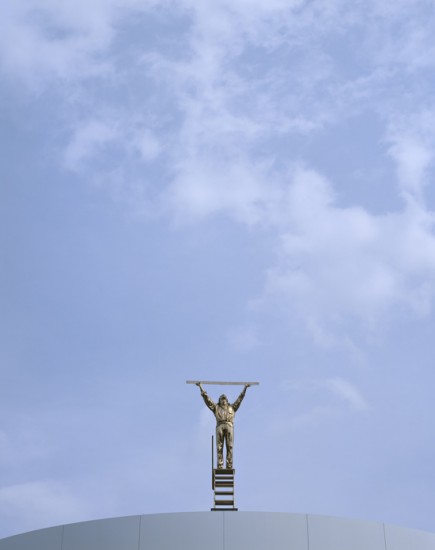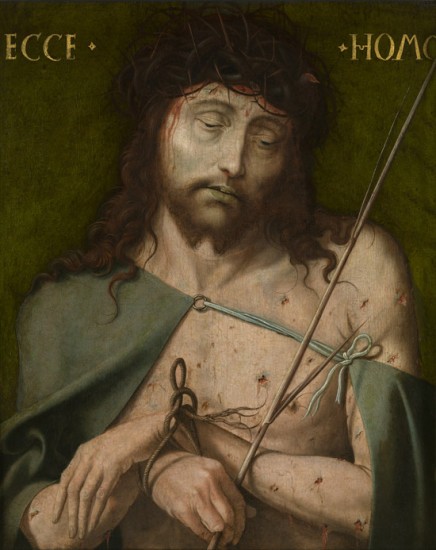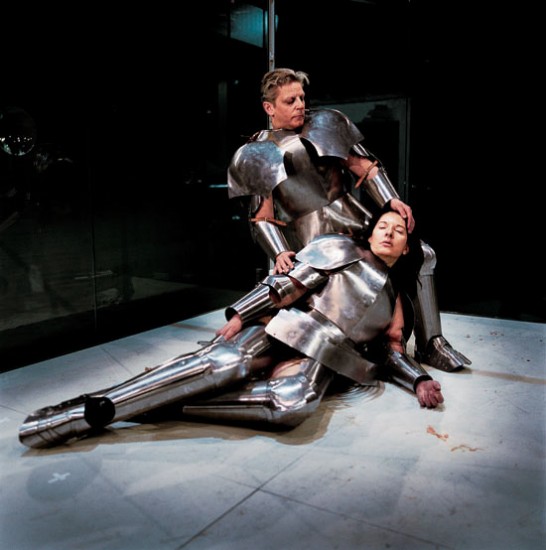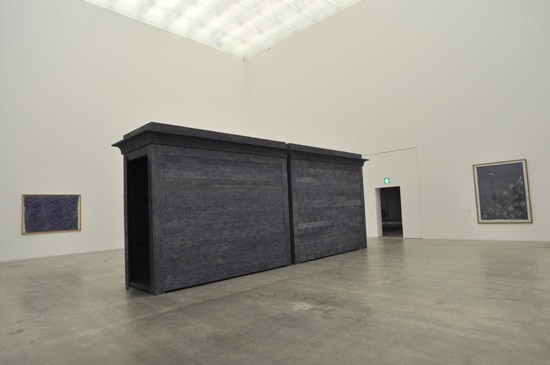Insomniac. Mystic. Anti-Christ.
By Andrew Maerkle
 The Man Who Measures the Clouds (1997), 21st Century Museum of Contemporary Art,
The Man Who Measures the Clouds (1997), 21st Century Museum of Contemporary Art, Kanazawa. Photo Atsushi Nakamichi / Nacása & Partners, © Angelos / Jan Fabre.
Over his roughly 30-year career, Antwerp-based artist and dramaturg Jan Fabre has consistently tested the limits of social taboo. As an artist, he has worked across media including drawings, sculptures, installations, performances and videos, and is known for using unconventional materials such as jewel-beetle shells, raw meat and human bone. Nor is Fabre shy of large scale. Seminal works include Tivoli (1990), for which he wrapped a castle in Mechelen, Belgium, with silk-paper cloth covered in Bic ballpoint pen drawings, and Heaven of Delight (2002), for which he decorated the ceiling frescoes in the Hall of Mirrors at the Royal Palace in Brussels with over a million beetle shells. His works often contain symbolic, allegorical elements, as with the exhibition “From the Cellar to the Attic – From the Feet to the Brain,” first held at Kunsthaus Bregenz in 2008 and then as a special presentation at the Venice Biennale in 2009, in which the exhibition’s five components corresponded to five different parts of the body: the feet, the “sex,” the belly, the heart and the brain. Corresponding to the sex, the installation Fountain of the World (as a young artist) (2008) comprised a lifelike sculptural figure of the artist as a young man sprawled on his back upon a pile of tombstones, his exposed erection spurting forth white fluid.
Among recent theater works, the solo piece Quando L’Uomo prinicipale è una Donna (When a leading man turns out to be a woman, 2004), is made for a female performer who executes both typically masculine and feminine gestures, and culminates with the performer sliding naked across a floor greased with olive oil that has leaked out of bottles suspended from the ceiling. An homage to blood, Je Suis Sang (I am Blood, 2003) incorporates Latin spoken parts alongside metal guitar sequences and imagery evoking Medieval torture. Referencing Nazi aesthetics, America’s Ku Klux Klan and the Abu Ghraib scandal, Orgy of Tolerance (2009) takes this further with sequences of masturbation contests, women giving birth while perched on shopping carts and performers shouting “Fuck Jan Fabre!”
Shocking though it may be, Fabre’s work is rooted in historical precedent. Fabre says that a visit to an exhibition in Bruges of Anonymous Master paintings of the flagellation and stigmata of Christ inspired him to turn to performance art and adapt the alchemy of painting to contemporary practices. Indebted to the tradition of Flemish painting even as he radically departs from it, Fabre has made a series of exhibitions juxtaposing his own works with historical masterpieces. His latest such exhibition is the two-person show “Alternative Humanities,” with Katsura Funakoshi, at the 21st Century Museum of Contemporary Art, Kanazawa. ART iT met with Fabre in Kanazawa to learn more about the ideas behind his work.
 Anonymous Master – Ecce Homo (16th century), Royal Museum of Fine Arts Antwerp.
Anonymous Master – Ecce Homo (16th century), Royal Museum of Fine Arts Antwerp.© Lukas – Art in Flanders VZW / Royal Museum of Fine Arts Antwerp.
ART iT: Your current exhibition here in Kanazawa is the latest in a series juxtaposing your own works with historical masterpieces of Flemish painting. Where do you see your own position with regard to that tradition?
JF: The Flemish masters are the inspiration source for all my work. For example, when you look at Bosch, he’s subversive, he’s full of imagination; he’s attacking the church, attacking power, attacking the politicians. When you look at Van Eyck, you think about the redefinition of space and anatomy. When you look at Rubens, you think about the dramaturgy of light. These people still inspire me today on different levels for different reasons.
I believe that avant-garde art is rooted in tradition. Tradition is something you have to taste, and taste very slowly, and experience. In that sense I am from the old school, an artist from the middle ages. I learned to take lapis lazuli and to mix it and prepare it, to make whites and to work with zinc. It was part of my education at the Royal Academy in Antwerp. But it was also natural for me, because I was always involved in science and experiments and my heroes were always scientists, and in that way I came to understand the notion of alchemy and research.
ART iT: Are you driven by any desire to reclaim the Flemish masters from the master narrative of European art history?
JF: The Flemish masters are important because they were the inventors of oil painting, and the inventors of the first paintings in which human proportions were the center of the composition. Compared to the Italian, French or German traditions, Flemish painting is almost like sex, drugs and rock’n’roll, because the painters were all about the celebration of life and death through depictions of drinking, feasting, dancing.
You will not find that in the other traditions because they were about the celebration of power. The Italian paintings were all about the celebration of luxury and wealth. Look to the Louvre – it’s a celebration of power and a glorification of being French.
But because the Flemish were always occupied, there was always an undercurrent of resistance in the works. When you look closely at Van Eyck’s Ghent Altarpiece (completed 1432) and study the side panels, he’s the first artist to include depictions of the patrons into the work – the private backers, not the church. In other words the Flemish masters introduced into their works allegories on the relation between capitalism and art. So there’s an intellectual irony there.
ART iT: You often use allegory in your own works as well. Does that limit them to a specific interpretation or is there room for multiple readings? For example, what are you thinking when you create a work like Searching for Utopia (2003), the larger-than-life outdoor sculpture of yourself riding a turtle into the sea?
JF: For me allegory is a door that opens to the imagination and the idea of consilience [or the unity of knowledge, through which different fields of study can inform each other]. Through consilience you can find new interpretations of the world and new links between different phenomena.
Searching for Utopia goes back to 1977 and even earlier. As a boy I had two pet turtles at home, and these turtles were very smart. For example, if you gave them a tomato, they would push it into the corner and then push back and forth until the skin of the tomato became soft and then they could eat the fruit. I used to make short 8mm films of the turtles and then in 1977 I made small clay models of myself riding them. Many years later thanks to the open-air exhibition “Beaufort” in Nieuwpoort, Belgium, I finally had the money to make a big bronze version of those models. So Searching for Utopia is based on these old works.
I think of the turtle as a kind of living stone, an oracle stone. You know in Delphi they used the turtle to speak the oracles. So I thought it was beautiful and I made this female turtle with myself as a young contemporary artist on top, heading into the sea searching for utopia on one of the oldest animals in the world.
ART iT: It’s surprising to see how creative you have been over the years as an artist and dramaturg. You’re doing one or two new stage productions every year in addition to making art.
JF: First of all I’m a classic insomniac, like my mother. I only sleep two hours a day. At night I draw or plan new sculptures, and then I direct my company during the day. In that sense I am a contemporary mystic. In Europe the mystics were labeled heretics by the Catholic Church, which taught its followers to accept suffering in this life so they could be reborn in the next. The mystics went further than simply believing in god, they tasted everything and knew everything, and from this knowledge of nature gained by experiencing things both physically and mentally, they could understand the idea of happiness. And that’s how I feel. I like to create, I like to make other people create. Were you to take that away from me I would die.
ART iT: Do you conceive your own work as being in an oppositional relationship to establishments like the state and church? Your recent performance piece Orgy of Tolerance, for example, seems intent on shocking viewers out of social entropy.
JF: I think in my work the model of Christ is very important, but at the same time I use the tactic of juxtaposition to make new models. My frequent use of insect shells is related to the idea of the exoskeleton as a new skin. When you have an exoskeleton like a beetle, you cannot wound yourself anymore, nor can you be wounded by anybody else. That means you leave behind, physically and mentally, the stigmata of Christ. In my mind, this new model can only exist because of the older model.
Orgy was a political statement against the extreme right, and against the consumerism that leads to acceptance of the extreme right. Sometimes I make theater pieces or texts that are really a reflection of what I feel at a particular moment: now I have to do this. Orgy is a completely different work from Je Suis Sang or my visual art pieces, which are like universes unto themselves with their own inner logic. Orgy is a theater play that talks directly to the public, it’s an action-reaction-type situation.
I needed to make my voice heard in my country. I’ve been Number One on the target list of the extreme right for 30 years now. I don’t want to be a victim to these people, even though they try to attack me physically and mentally. It’s important as an artist to open your mouth. Some works want to do this, and other works don’t want to do this; they want to be quiet.
ART iT: But of course the paradox of democracy is the idea of tolerance.
JF: Well, the piece was exactly about the “orgy of tolerance.” I believe that to defend a democracy you have to be careful. The hypocrisy of democracy in Belgium and other European countries is that if you want to make an extreme right party, you only need two signatures from the socialists or the Catholics or the liberals to make this party. The democracy undermines itself by its own tolerance. To be honest, I would rather not be tolerant. The far right represents the opposite of freedom, the opposite of individualism. And this I cannot accept.
 Performance view of Virgin / Warrior (2004) by Marina Abramović and Jan Fabre at Palais de Tokyo, Paris.
Performance view of Virgin / Warrior (2004) by Marina Abramović and Jan Fabre at Palais de Tokyo, Paris. Photo Attilio Maranzano, © Angelos.
ART iT: You also use the word warrior to describe yourself and your performers, as in the performance collaboration with Marina Abramović, Virgin / Warrior (2004), in which the two of you dress up in Medieval body armor. Is that coming from European ideas of chivalry and the common Christian invocation of the warrior metaphor? Why do you need to invoke that for art?
JF: I am a romantic artist and I believe that the real chevaliers fought for good causes. The idea of defending the weak or the poor is a good cause, and for me to be a chevalier of beauty is to defend art, to defend the vulnerability of beauty. In many of the works of the Flemish masters there’s a kind of belief in humanity, and I think my work is also connected with this through its refusal of cynicism. I see this as an alternative to a lot of international art today that expresses a very cynical viewpoint.
ART iT: Do you think beauty and art are under attack in contemporary Europe?
JF: They are constantly under attack. Look at the way politicians think about society, look at the way the media manipulates images of beauty and art, or manipulates images of the human body. Think about women, for example. In advertisements for menstruation products the media always use blue liquid instead of red liquid. So that means today even in 2010 we still cannot accept the blood of menstruation, and regard it as something negative. Yet researchers have found that menstruation blood is in fact very fertile. This is a case of the media, or the power behind the media, manipulating our bodies. So all of my work goes against this kind of manipulation.
ART iT: You mention that Orgy comes from a very immediate source of inspiration. Do you ever participate in your own theater productions?
JF: No, I’m a lousy actor. Acting is a craft, and my performers are very well trained actors and dancers. I teach my actors my experiences – the real actions, the real time, the real physical suffering I go through – and then they translate that with their own techniques.
When I began working as a choreographer three things were important. Saturday afternoon, 10 years old, it was raining outside, I was watching Fred Astaire every weekend. I thought he was a genius dancer, a stylish man – this stayed with me. Later at the Royal Academy I spent six years studying anatomy, muscles, the skeleton, so I knew how the body functions. Then I fell in love with a dancer. Fred Astaire was in the back of my mind, I knew the skeleton and I started working with a dancer, and of course now I’ve been doing this for 25 or 30 years.
Some of my dancers from the first generation have now become my arms and my legs, in that they are now my assistants. I have developed a kind of language with them so that now when I direct the choreography I make a few movements, I show them the articulation and everything, and they understand me, although of course they do it much better than I do.
I have also developed various methods and exercises. I have my actors study entomology. They have to understand the mechanics and the kinetic intelligence of insects and animals, and they have to translate that into movement. This goes back to the idea of consilience.
But the reason why I like to make theater with my company is that it’s an exchange of energy, and an exchange of wisdom, because I also learn from my actors and dancers. I learn from their kinetic intelligence, which I sometimes later use for my own sculptures or installations. It feeds me in both ways. I need it for my own energy, because I am so alone at night – really lonely – that I need to spend time with people and to create together during the day.
 Installation view of Scissor House (1990) at the 21st Century Museum of Contemporary Art, Kanazawa. Private Collection, courtesy Deweer Art Gallery, Otegem.
Installation view of Scissor House (1990) at the 21st Century Museum of Contemporary Art, Kanazawa. Private Collection, courtesy Deweer Art Gallery, Otegem.ART iT: I’d like to return to the idea of alchemy. Do you see your own works transforming once they are exposed to the outside world, the way that blood turns red when it is exposed to air?
JF: I count on this. In the room here in Kanazawa with the installation Scissor House (1990) you will see my drawings made with Bic ballpoint pens. Some papers are prepared so that the blue will stay, others are prepared so that the blue will leach out and you will only see the imprint of the pressure of the pen. I like that the Bic ink is a chemical substance that is always changing. It becomes blue, red, or even green or violet when you show a work in a different museum. The works are constantly undergoing different chemical reactions. I like this idea. It’s the same with the carapace of the jewel beetle, which has a natural prismacolor effect in that the patterns change in relation to how the light falls on the shells. I like this idea of the alchemistic behavior of material and color, and the living quality in that it’s constantly changing according to time, place and light.
“Alternative Humanities: Jan Fabre x Katsura Funakoshi” continues at the 21st Century Museum of Contemporary Art, Kanazawa, through August 31.
Related:
Picks: Jan Fabre & Katsura Funakoshi
